Category Archives: Jewelry
Jewelry: What’s PT?
Often mistaken for silver, platinum is worth far more than silver and is usually worth more than gold. Recently, gold prices have surpassed platinum, but that is not typical, and they are back–today at least–to their normal relative position now. (Gold is around 1250.00 and platinum is around 1350.00) Platinum jewelry will have PLAT or PT marked on it. There might also be a number with those letters to indicate how many parts per thousand are platinum, like 850 PT or 950 PLAT.
Don’t be cheated: Learn how to sell the genuine gold jewelry you’ve inherited.
 Selling gold is an area where you are likely to find a lot of cheats, so go into it with your eyes wide open. Before you take gold jewelry anywhere, bone up on the current price for gold—check on the Internet or in the newspaper. This shows the buyer that you aren’t totally clueless, and you’ll be less likely to get cheated. Gold is priced per troy ounce, a measurement slightly different from regular ounces. Make your own ballpark estimate before trying to sell. Here’s how.
Selling gold is an area where you are likely to find a lot of cheats, so go into it with your eyes wide open. Before you take gold jewelry anywhere, bone up on the current price for gold—check on the Internet or in the newspaper. This shows the buyer that you aren’t totally clueless, and you’ll be less likely to get cheated. Gold is priced per troy ounce, a measurement slightly different from regular ounces. Make your own ballpark estimate before trying to sell. Here’s how.
–Examine the karat mark of your jewelry items and divide into piles. Most will be 10k, 12k, 14k, or 18k. If it isn’t marked, it is probably gold plated or gold wash and worth next to nothing.
–Weigh each group separately on a postal scale to determine number of ounces.
–Convert ounces into troy ounces using an online converter or do it yourself by multiplying regular ounces by .912. (Gold prices are quoted in troy ounces.)
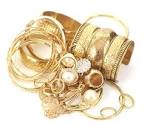 –Deduct a percent for the part that isn’t gold. 10 karat is 41% gold, so you’d deduct 59%. 12 karat is 50% gold. 14 karat is 58% gold. 18 karat is 75% gold, and the highest you are likely to see in America. 22 karat is 91% gold. 24 karat is pure gold. So 20 troy ounces of 12 karat gold equals 10 troy ounces of pure gold. Why don’t you see much 22 or 24 k gold in America? Because it’s too soft to make good jewelry. A neckchain of 24 k gold would pull apart with minimal effort.
–Deduct a percent for the part that isn’t gold. 10 karat is 41% gold, so you’d deduct 59%. 12 karat is 50% gold. 14 karat is 58% gold. 18 karat is 75% gold, and the highest you are likely to see in America. 22 karat is 91% gold. 24 karat is pure gold. So 20 troy ounces of 12 karat gold equals 10 troy ounces of pure gold. Why don’t you see much 22 or 24 k gold in America? Because it’s too soft to make good jewelry. A neckchain of 24 k gold would pull apart with minimal effort.
–Multiply by the current troy ounce price.
That is what your gold is worth at retail, but of course you will not get that much for it. You are selling at wholesale–the buyer will sell at retail. Many dealers will offer you half the retail value. Shop around to get the best price. Reputable gold buyers should pay 80% or maybe 90% of the retail value. Knowing approximately what that is will protect you.
True story: Fatima took her unwanted gold jewelry to a gold buyer who dumped it all on the scales, weighed it, and quoted a price based on 14k. “But isn’t this worth more?” she asked, indicating the mark on one piece that said 22k, an alloy common in India where she is from. The buyer, who of course “hadn’t noticed,” recalculated and offered her a higher figure. (She should have walked out the minute she realized he was dishonest.) Moral? Examine each piece and estimate it’s worth before you see a buyer.
Yes, there are pawnshops, online buyers, mail order schemes, and fly-by-nights who breeze into town and set up shop in a hotel room, but your best bet by far is a reputable, local jewelry store or coin dealer that buys gold and silver and sticks around for his reputation to matter. Let the buyer know up front that you are going to get two or three offers before selling and hold to that plan.
Gold-looking jewelry made in the twentieth century is sometimes marked GF for gold-filled, a deceptive term that means a very thin layer of gold over base metal. Watch out for 14k GF, which sounds better but is still just a thin, thin, thin coat of gold. It is worthless as gold, but it may have value as costume jewelry or vintage jewelry.
What about all that costume jewelry in Grandma’s closet?
 Well, gee, as long as your 100% CERTAIN it’s costume . . .
Well, gee, as long as your 100% CERTAIN it’s costume . . .
Vintage costume jewelry can bring in good money when it is sold online, especially if it is sparkly or signed by a desirable company like Trifari, Coro, Weiss, Sarah Coventry, Lisner, Money, Napier, and Ann Klein. And it has the advantage of being easy and inexpensive to mail. Take a good close-up photo and give it a go. Or hire a teenager to handle the sales for you, if you’re not fluent in eBay. Such jewelry is also welcome as a donation to nonprofits like Goodwill that resell to the public.
Jewelry that is reminiscent of the past, such as Art Nouveau or Art Deco, will find a ready market, even if it doesn’t really date from that era. Some people are shopping for a “look,” and the actual date doesn’t matter.
But please, please, please, before you try to sell or donate, take a box full of jewelry to your local, reputable jewelry shop and ask your friendly, honest jeweler if it is all, indeed, costume jewelry. They can eyeball it and give you a quick answer, and as long as they’re not busy, they won’t mind. (Call first and ask when you could drop by at a slow time.)
Don’t try this test on your diamond!
 You may have heard that a real diamond will scratch glass and an imitation one won’t. If only it were that easy! Many high quality imitation diamonds are harder than glass, so even some of the fakes will scratch glass.
You may have heard that a real diamond will scratch glass and an imitation one won’t. If only it were that easy! Many high quality imitation diamonds are harder than glass, so even some of the fakes will scratch glass.
Don’t rely on these myths to determine whether your inherited diamond-looking piece of jewelry is genuine or not. Take it to a reputable, local jewelry, one who has been in business for many years, and he or she will tell you at no cost whether it is genuine or not. They will not appraise it at no cost, and they probably aren’t able to anyway. Pay for an appraisal from an experienced CGA or Certified Gemologist Appraiser. These people have the training to judge your jewelry and, equally important, they have no interest in buying it, so they have no incentive to lowball their estimates.
So how did this myth get started? It probably was true in the past, when imitation diamonds were made of something called “paste.” Not the sort of paste you used in kindergarten to glue lace to your Valentine, this word meant a type of glass with a high lead content that was used to make imitation stones. According to the Encyclopedia Britannica, the Romans were the first to make this sort of imitation stone. For all you chemists, here’s the lowdown:
“Before 1940 most imitation gems were made from glass with a high lead content. Such glasses were called paste because the components of the mixture were mixed wet to ensure a thorough and even distribution. Colourless paste is commonly formulated from 300 parts of silica (silicon dioxide, SiO2), 470 of red lead (a lead oxide, Pb3O4), 163 of potassium carbonate (K2CO3), 22 of borax (a sodium borate, Na2B4O7·10H2O), and 1 of white arsenic (arsenic oxide, As2O3). Pigments may be added to give the paste any desired colour: chromium compounds for red or green, cobalt for blue, gold for red, iron for yellow to green, manganese for purple, and selenium for red.”
Should you sell those old accessories to a vintage clothing store?
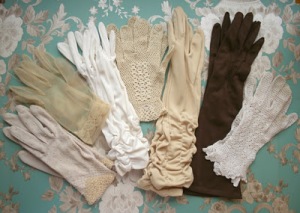 Vintage shops sell more than clothing. They also carry period accessories such as cuff links, stickpins, hatpins, tie clips, hats, gloves, scarves, coats, shoes, shawls, lace, fans, evening bags, handkerchiefs, furs, and jewelry.
Vintage shops sell more than clothing. They also carry period accessories such as cuff links, stickpins, hatpins, tie clips, hats, gloves, scarves, coats, shoes, shawls, lace, fans, evening bags, handkerchiefs, furs, and jewelry.
If the jewelry, cuff links, hatpins, and tie clips you want to get rid of is made of gold or silver (there will be marks like 18K, 14K, or 10K on the gold and STER, STERLING, 925, or 900 on the silver, or even PLAT or PT for platinum) and has stones, chances are the stones are genuine. It isn’t common to put cheap, “paste” stones in silver or gold settings. Same with pearls–pearls with 14K gold clasps are probably genuine. These pieces should be taken to a reputable jeweler, preferably two or three, to see what they say. If the metal has no marks, it’s likely the piece is costume jewelry and that is the sort you should take to a vintage clothing shop to sell.
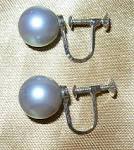 Speaking of jewelry, one clue in estimating the date of your jewelry is to look at the earrings. Lever-back or screw-back earrings came in around the early years of the 20th century and faded during the forties. The spring clip is a little later, around the thirties and faded in the sixties when pierced ears became fashionable. Not conclusive, but suggestive.
Speaking of jewelry, one clue in estimating the date of your jewelry is to look at the earrings. Lever-back or screw-back earrings came in around the early years of the 20th century and faded during the forties. The spring clip is a little later, around the thirties and faded in the sixties when pierced ears became fashionable. Not conclusive, but suggestive.
Tips for selling Stuff to vintage clothing stores
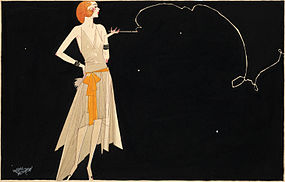 Items from the Fifties and the Roaring Twenties are in special demand now. Movies and programs like The Great Gatsby and Boardwalk Empire are turning public attention to the 1920s, while serials like Mad Men bring attention to the Fifties and Sixties.
Items from the Fifties and the Roaring Twenties are in special demand now. Movies and programs like The Great Gatsby and Boardwalk Empire are turning public attention to the 1920s, while serials like Mad Men bring attention to the Fifties and Sixties.
 Wedding gowns and military uniforms are often sold at vintage stores.
Wedding gowns and military uniforms are often sold at vintage stores.
Before Halloween, vintage clothing shops become costume shops. Before Christmas, they sell a lot of jewelry. That means you are more likely to sell your Stuff, and get a better price for it, in September and November when shop owners are looking for a quick turnover.  Bring costume jewelry to a vintage store for consideration; bring fine jewelry to a jeweler that has a vintage section (most do). If you’re not sure whether the stones are real, a reputable jeweler can tell you at a glance and for no charge. (They will not appraise the item for no charge–that service costs.)
Bring costume jewelry to a vintage store for consideration; bring fine jewelry to a jeweler that has a vintage section (most do). If you’re not sure whether the stones are real, a reputable jeweler can tell you at a glance and for no charge. (They will not appraise the item for no charge–that service costs.)
Dad was a Mason? What now? Fraternal jewelry and all that jazz.
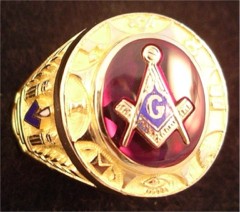 What should you do with the fraternal jewelry you come across in the estate you’ve inherited? By “fraternal jewelry” I mean Masonic rings, sorority and fraternity pins, military academy rings, lapel pins, and other logo items that have special meaning to a particular organization. Fraternal groups ask that all such jewelry be returned to the organization, since these items shouldn’t be worn by anyone except their members.
What should you do with the fraternal jewelry you come across in the estate you’ve inherited? By “fraternal jewelry” I mean Masonic rings, sorority and fraternity pins, military academy rings, lapel pins, and other logo items that have special meaning to a particular organization. Fraternal groups ask that all such jewelry be returned to the organization, since these items shouldn’t be worn by anyone except their members.
Drop the piece in a padded envelope and mail to the local chapter or national headquarters or service academy. You’ll get nothing for it (except thanks and a good feeling), so if there is a precious stone in the ring, for heaven’s sake, have it removed by a jeweler. If the item is gold or silver, you may prefer to sell it for meltdown.
Fraternal organizations are also grateful when you return other logo items such as caps, fez, books, and papers. I think of this as a way to honor the deceased, who no doubt valued these items very much.
Faux Pearls or Real? The Tooth Test
 Have you heard that you can tell if pearls are real by using your teeth? You probably heard it from your grandmother or great aunt. Is this an old wives’ tale?
Have you heard that you can tell if pearls are real by using your teeth? You probably heard it from your grandmother or great aunt. Is this an old wives’ tale?
 Nope, it’s true. Real pearls rubbed gently across your teeth will feel a little gritty. A caveat though. (Isn’t there always one?) This can be hard to tell without having fake pearls for comparison.
Nope, it’s true. Real pearls rubbed gently across your teeth will feel a little gritty. A caveat though. (Isn’t there always one?) This can be hard to tell without having fake pearls for comparison.
Get some pearls you know are fake or some other beads made of glass and rub them across the biting edge of your top teeth. They will feel smooth. Then try the mystery pearls. If they feel the same, they are most likely fakes. Or faux, as today’s sensitive marketplace prefers. If they feel gritty by comparison, they are most likely genuine.
Another clue: check the clasp. If it is real gold (marked 14K or similar) or platinum, the pearls are likely genuine. No one puts cheap clasps on real pearls or expensive clasps on fakes.
If you still can’t tell, take them to a reputable jeweler–he or she will identify them for free. Most jewelers can arrange for an appraisal if you like, but you will have to pay for that service.
